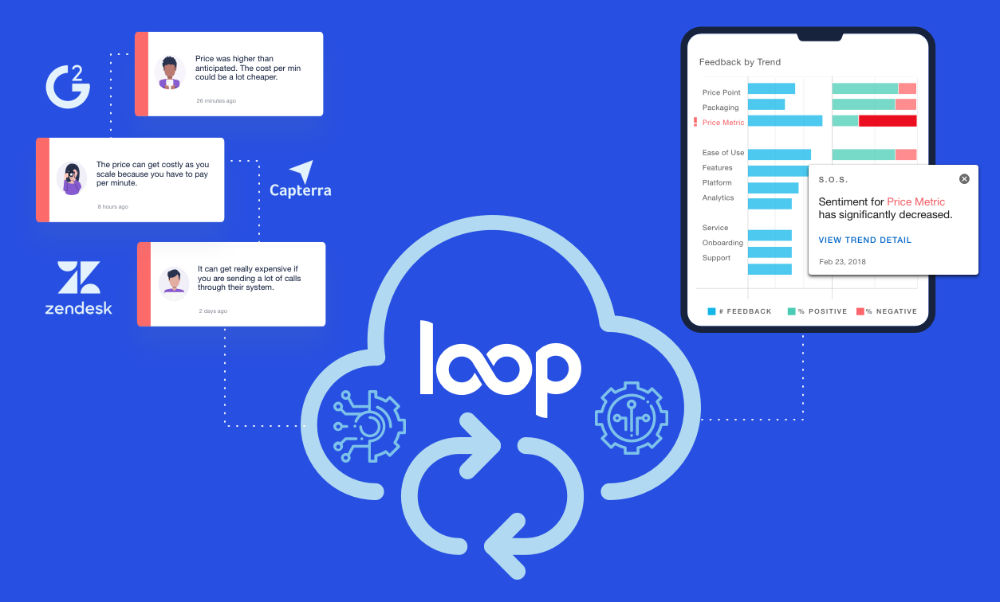Home » How to Build a Cross-Functional Team for Voice of the Customer Collaboration
How to Build a Cross-Functional Team for Voice of the Customer Collaboration
Madeline Turner
Chief Marketing Officer, LoopVOC

One of the biggest barriers to an organization’s long-term success in this age of digital transformation will be the successful execution of cross-functional collaboration. As organizations grow and departments are formed with designated goals and responsibilities, silos are naturally created. Within these silos, departments have their own goals, responsibilities, processes, and priorities. The silos don’t generally happen because people are opposed to collaboration. They happen because our success is measured on performance toward specific business objectives.
Collaboration around a different department’s new initiative sounds nice. But with demand for results around our own department’s priorities dictating our day-to-day, who has time for anything that isn’t critical?
Because of this, important initiatives fall on the back burner or are left up to one department— or even one person—to lead and execute. We may be able to move the needle in some areas, but transforming a culture or the customer experience without all-hands on deck is rarely possible.
Making customer feedback central to business operations and decision making isn’t possible unless there is a shared vision and goals across the organization. Otherwise, we end up with critical initiatives being owned and driven by single departments that lack the authority to enact change outside of their organization. Sure, recommendations can be made, but the line stops there.
Voice of the Customer programs require cross-organizational collaboration to succeed.
According to Harvard Business Review, 75% of cross-functional teams are dysfunctional. But this failure rate isn’t a reason to disregard the importance of a cross-functional team. Rather, it’s a signal that our approach must be more deliberate and systematic.
6 Steps to Build Your Cross-Functional VOC Team
Step 1. Get leadership buy-in to assemble the cross-functional team
Sounds simple, but it’s not always easy getting buy-in to do something new (especially if there will be resources needed or priorities shifting).
Demonstrate why a VOC program is critical to your business.
- Dipping sales?
- Declining customer retention?
- Product usage concerns?
- Increase in customer support calls?
- Poor results with customer marketing campaigns?
Build your business case around business priorities—speak the language that resonates with business leaders. From there, your ask will be to endorse a cross-functional team made up of stakeholders from key departments. Ideally, you would include stakeholders from the following departments:
- Product Marketing
- Customer Success
- Customer Marketing
- Product Management
- Project Management
- Sales
- Customer Support
Step 2: Establish Shared Goals
When establishing a cross-functional team, one of the first barriers to overcome will be a misalignment on goals and priorities. Naturally, team members may have their own agenda tied to their department’s goals. It’s not a problem to come to the table with ideas and context, but decisions made about the initiative can’t be dictated by this. Team members have to let go of territorial or “we’ve always done it this way” mentality and embrace a shared vision.
Defining a shared vision will help ensure that all stakeholders are working together towards a common goal.
Examples of Voice of the Customer Goals:
- Ensure brand promise is reflected in all customer touchpoints
- Deliver exceptional customer experience from interest through purchase
- Make customer feedback central to all business decision making
- Operationalize customer feedback for visibility and accountability across the organization
A unified vision for your program will help cross-functional team members rally around the purpose of the work required and champion the importance of changes needed to make the vision a reality.
Step 3: Define Roles and Responsibilities
Once you’ve established your vision for the program and outlined specific goals to enable that vision, you’ll be primed to outline roles and responsibilities for each team member.
Lauren: Lots of conversations with teams, pointing at the expertise through that.
Talk to tons of SaaS companies every day – in these conversations, almost every company is tag-teaming this in a different way. Not a clearly defined process, some have a VOC role that quarterbacks the effort. But at most companies, joint collaboration.
One of the best models to ensure ownership and accountability is the RACI matrix, which outlines who is Responsible, Accountable, Consulted, or Informed for each line item. The benefit of using the RACI model when launching new programs or initiatives is that it clearly defines the roles each employee plays in ensuring long-term growth for your program and your customers.
Step 4: Develop a Communication Plan
Sounds simple, I know. But setting expectations upfront for how the cross-functional team will work together is essential. If you’ve ever been a part of a cross-functional project before, you probably know what it’s like to have no real sense of how you should be collaborating or communicating on an ongoing basis, or even who to go to for what.
Set the stage early. Make sure that that this group of people from different areas get to know each other and feel comfortable when they work together.
- Outline communication plans for the following:
- Daily Collaboration
- Ongoing Status Updates
- Meeting Frequency
- Agenda Setting and Meeting Owners
- Preferred Deliverable Formats (if there is a preference)
Step 5: Measure and Evaluate Results
Assuming you’ve defined KPIs for each goal, tracking your progress to achievement or completion will be key to proving the impact of your efforts.
Simple steps (and examples) for getting started with measuring the impact of your VOC program are below.
- Determine what you’ll measure (Customer sentiment regarding new product changes)
- Determine how you will measure it (Combination of NPS quantitative and qualitative feedback, Zendesk tickets, CRM notes, online review feedback)
- Determine systems/tools needed to measure (you can either aggregate all of this information and then manually comb through feedback and identify trends or you can use a tool like LoopVOC to help do this for you).
- Determine cadence for measuring and reporting out (Monthly and Quarterly to track sentiment trends over time)
Step 6: Implement Voice of the Customer Collaboration Tools
Is it possible to implement a cross-organizational Voice of the Customer program at your organization without a tool that puts customer feedback and collaboration together in one place? Yes. Will the manual effort required to do so mean increased time and resources? Also, yes.
Using natural language processing, Loop connects feedback across sources, extracts meaningful insights from customer feedback, so that VOC teams can proactively identify issues impacting retention and sales, and pivot company initiatives to address them.
Once teams are collaborating in Loop, it is super easy to assign actions and share links to specific feedback, reports, and action plans.
- Assign a specific action to a team member based on trends in customer feedback
- Use filters to curate important views and share links with team members for visibility
- Track the impact of the actions on customer feedback over time
We’ve seen the best use of Loop happen when people” across functions have access to the tool. From cross-functional leaders in Customer Experience, Product Management, Project Management, and Marketing, to frontline representatives in Sales, Services, and Support, being able to understand customer feedback in real-time can drive major value across your company and for your customers.
Share on facebook
Share on twitter
Share on linkedin



